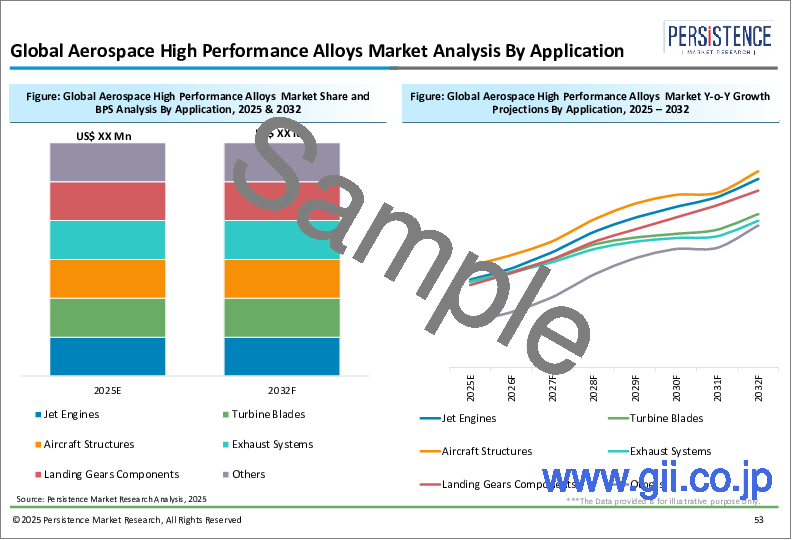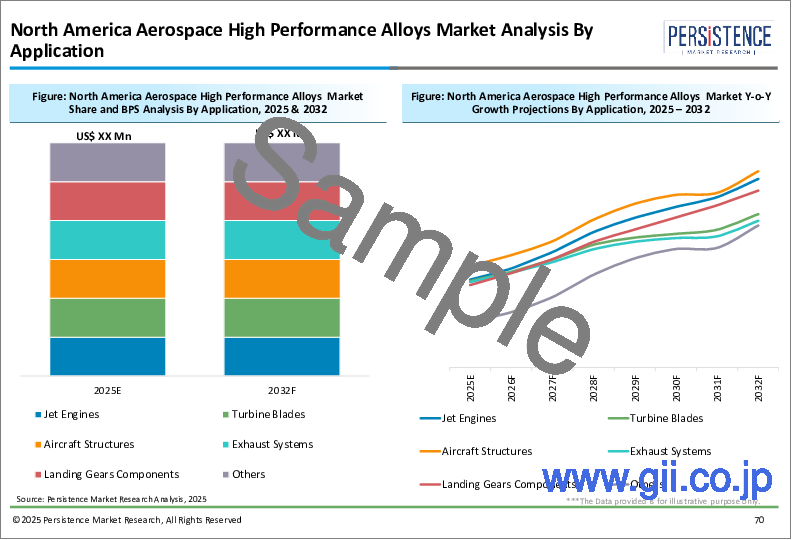|
|
市場調査レポート
商品コード
1547072
航空宇宙用高性能合金市場:世界の産業分析、規模、シェア、成長、動向、予測、2024年~2031年Aerospace High Performance Alloys Market: Global Industry Analysis, Size, Share, Growth, Trends, and Forecast, 2024-2031 |
||||||
カスタマイズ可能
|
|||||||
| 航空宇宙用高性能合金市場:世界の産業分析、規模、シェア、成長、動向、予測、2024年~2031年 |
|
出版日: 2024年08月23日
発行: Persistence Market Research
ページ情報: 英文 160 Pages
納期: 2~5営業日
|
- 全表示
- 概要
- 目次
Persistence Market Researchはこのほど、世界の航空宇宙用高性能合金市場に関する広範なレポートを発行しました。当レポートでは、促進要因・動向・機会・課題などの主要な市場力学を包括的に分析し、市場構造に関する深い洞察を提供しています。
主要な洞察
- 航空宇宙用高性能合金の市場規模(2024年):2億3,780万米ドル
- 予測市場金額(2031年):3億7,940万米ドル
- 世界市場成長率(CAGR 2024年~2031年):6.9%
航空宇宙用高性能合金市場 - レポート範囲:
航空宇宙用高性能合金市場には、航空宇宙用途の厳しい要求を満たすように設計された様々な先端合金材料が含まれます。ニッケル、チタン、アルミニウムベースの合金を含むこれらの合金は、航空宇宙事業で遭遇する極端な温度、圧力、環境条件に耐えるように設計されています。この市場は、民間航空機、軍用機、宇宙船、整備・修理・オーバーホール(MRO)サービスなど、多様な分野にサービスを提供しています。成長の促進力は、燃料効率の高い航空機に対する需要の増加、材料科学の進歩、新しい航空宇宙設計や技術におけるこれらの合金の応用拡大です。
市場成長の促進要因:
航空宇宙用高性能合金の世界市場を促進している主要な要因はいくつかあります。軽量で燃料効率の高い航空機に対する需要の高まりは重要な促進要因であり、高性能合金は強度と耐久性を維持しながら航空機構造の重量を減らす上で重要な役割を果たしています。アディティブ・マニュファクチャリングや高度な鋳造技術など、冶金学の技術的進歩が航空宇宙用合金の特性を向上させ、市場拡大にさらに拍車をかけています。さらに、環境の持続可能性への関心の高まりと次世代航空機技術の開発が、排出ガスの削減と燃費の改善に貢献する高性能合金の需要を促進しています。研究開発活動の強化は、新しい合金組成や加工方法の導入とともに、航空宇宙メーカーや事業者により適合したソリューションを提供することで市場の成長に寄与しています。
市場抑制要因:
有望な成長展望にもかかわらず、航空宇宙用高性能合金市場は、原材料の高コストと製造工程の複雑さに関連する課題に直面しています。市場の成長は、より低コストで同様の性能上の利点を提供する可能性のある複合材料などの代替材料の利用可能性によって妨げられる可能性があります。さらに、特定の合金のリサイクル性や環境への影響に関する懸念は、特に航空宇宙産業がより持続可能な慣行へと移行する中で、市場拡大の課題となっています。これらの問題に対処するには、航空宇宙用合金の費用対効果と持続可能性を改善するための研究開発への継続的な投資と、航空宇宙産業の進化するニーズに対応できる新しい合金の開発が必要です。
市場機会:
この市場は、材料の無駄を減らして複雑な合金部品を製造することを可能にする付加製造などの高度な製造技術の採用の増加によって促進される大きな機会を提示しています。次世代航空宇宙エンジン用の高温合金の開発や、宇宙探査用途での合金需要の高まりは、さらなる成長の道を提供します。世界の航空宇宙産業、特に新興市場における航空宇宙産業の拡大は、各国が航空宇宙能力の開拓に投資しているため、市場成長の新たな機会を提供しています。戦略的パートナーシップ、先端製造技術への投資、軽量・高性能合金の採用は、新たな機会を活用し、市場のリーダーシップを維持するために不可欠です。
本レポートで扱う主要な質問
- 航空宇宙用高性能合金市場の世界的成長を促進する主要な要因は何か?
- 様々な航空宇宙用途で採用をリードしている高性能合金の種類と組成は?
- 技術進歩は航空宇宙用高性能合金市場の競合情勢にどのような影響を与えているか?
- 航空宇宙用高性能合金市場の主要企業はどこで、競争力を維持するためにどのような戦略を採用しているのか?
- 航空宇宙用高性能合金の世界市場における新たな動向と将来性は?
目次
第1章 エグゼクティブサマリー
第2章 市場概要
- 市場の範囲と定義
- 市場力学
- 促進要因
- 抑制要因
- 機会
- 課題
- 主要な動向
- マクロ経済要因
- 世界のセクター別展望
- 世界のGDP成長展望
- 世界の航空宇宙市場の展望
- 世界の防衛セクターの展望
- 世界の鉱業市場の展望
- COVID-19の影響分析
- 予測要因 - 関連性と影響
第3章 付加価値の洞察
- 合金タイプの採用分析
- 合金タイプの評価
- 規制状況
- バリューチェーン分析
- 原材料サプライヤー一覧
- メーカー一覧
- 販売代理店一覧
- 収益性分析
- 主要な取引と合併
- PESTLE分析
- ポーターのファイブフォース分析
- 地政学的緊張:市場への影響
第4章 価格動向分析、2024年~2031年
- 主要なハイライト
- 合金タイプの価格に影響を与える主要な要因
- 価格分析:タイプ別
- 地域別価格と合金タイプの選好
第5章 世界の航空宇宙用高性能合金市場の展望:実績(2019年~2023年)と予測(2024年~2031)
- 主要なハイライト
- 市場数量(単位)予測
- 市場規模(百万米ドル)と前年比成長率
- 絶対額の機会
- 市場規模(百万米ドル)分析と予測
- 過去の市場規模(百万米ドル)分析、2019年~2023年
- 現在の市場規模(百万米ドル)分析と予測、2024年~2031年
- 世界の航空宇宙用高性能合金市場の展望:合金タイプ
- イントロダクション / 主要な調査結果
- 過去の市場規模(百万米ドル)分析、合金タイプ別、2019年~2023年
- 現在の市場規模(百万米ドル)予測、合金タイプ別、2024年~2031年
- 市場の魅力分析:合金タイプ
- 世界の航空宇宙用高性能合金市場の展望:用途
- イントロダクション / 主要な調査結果
- 過去の市場規模(百万米ドル)分析、用途別、2019年~2023年
- 現在の市場規模(百万米ドル)分析と予測、用途別、2024年~2031年
- 市場の魅力分析:用途
第6章 世界の航空宇宙用高性能合金市場の展望:地域
- 主要なハイライト
- 過去の市場規模(百万米ドル)分析、地域別、2019年~2023年
- 現在の市場規模(百万米ドル)予測、地域別、2024年~2031年
- 北米
- 欧州
- 東アジア
- 南アジア・オセアニア
- ラテンアメリカ
- 中東・アフリカ
- 市場の魅力分析:地域
第7章 北米の航空宇宙用高性能合金市場の展望:実績(2019年~2023年)と予測(2024年~2031年)
第8章 欧州の航空宇宙用高性能合金市場の展望:実績(2019年~2023年)と予測(2024年~2031年)
第9章 東アジアの航空宇宙用高性能合金市場の展望:実績(2019年~2023年)と予測(2024年~2031年)
第10章 南アジア・オセアニアの航空宇宙用高性能合金市場の展望:実績(2019年~2023年)と予測(2024年~2031年)
第11章 ラテンアメリカの航空宇宙用高性能合金市場の展望:実績(2019年~2023年)と予測(2024年~2031年)
第12章 中東・アフリカの航空宇宙用高性能合金市場の展望:実績(2019年~2023年)と予測(2024年~2031年)
第13章 競合情勢
- 市場シェア分析、2023年
- 市場構造
- 競合激化マップ:市場別
- 競合ダッシュボード
- 企業プロファイル(詳細 - 概要、財務、戦略、最近の動向)
- Precision Castparts Corp.
- CRS Holdings, LLC(Carpenter)
- HAYNES INTERNATIONAL
- ATI Materials
- Thyssenkrupp Aerospace
- Continental Steel &Tube Company
- Kennametal Inc.
- VSMPO-AVISMA
- Aviva Metals
- Tata Steel
- Kobe Steel Limited
- NeoNickel
- Alcoa
- Constellium
第14章 付録
- 調査手法
- 調査の前提条件
- 頭字語と略語
Persistence Market Research has recently published an extensive report on the global Aerospace High Performance Alloys Market. This report offers a comprehensive analysis of the key market dynamics, including drivers, trends, opportunities, and challenges, providing deep insights into the market structure.
Key Insights:
- Aerospace High Performance Alloys Market Size (2024E): US$237.8 Mn
- Projected Market Value (2031F): US$ 379.4 Mn
- Global Market Growth Rate (CAGR 2024 to 2031): 6.9%
Aerospace High Performance Alloys Market - Report Scope:
The Aerospace High Performance Alloys Market encompasses a variety of advanced alloy materials designed to meet the rigorous demands of aerospace applications. These alloys, which include nickel, titanium, and aluminum-based alloys, are engineered to withstand extreme temperatures, pressures, and environmental conditions encountered in aerospace operations. The market serves diverse segments, including commercial aircraft, military aircraft, space vehicles, and maintenance, repair, and overhaul (MRO) services. Growth is driven by the increasing demand for fuel-efficient aircraft, advancements in material science, and the expanding application of these alloys in new aerospace designs and technologies.
Market Growth Drivers:
Several key factors are driving the global Aerospace High Performance Alloys Market. The rising demand for lightweight, fuel-efficient aircraft is a significant driver, as high-performance alloys play a crucial role in reducing the weight of aircraft structures while maintaining strength and durability. Technological advancements in metallurgy, such as additive manufacturing and advanced casting techniques, have enhanced the properties of aerospace alloys, further fueling market expansion. Additionally, the increasing focus on environmental sustainability and the development of next-generation aircraft technologies drive demand for high-performance alloys that contribute to reduced emissions and improved fuel efficiency. Enhanced research and development activities, along with the introduction of new alloy compositions and processing methods, contribute to market growth by offering more tailored solutions for aerospace manufacturers and operators.
Market Restraints:
Despite promising growth prospects, the Aerospace High Performance Alloys Market faces challenges related to the high costs of raw materials and the complexity of manufacturing processes. The market growth can be hindered by the availability of alternative materials, such as composites, which may offer similar performance benefits at a lower cost. Additionally, concerns about the recyclability and environmental impact of certain alloys pose challenges for market expansion, especially as the aerospace industry moves towards more sustainable practices. Addressing these issues requires ongoing investment in research and development to improve the cost-effectiveness and sustainability of aerospace alloys, as well as to develop new alloys that can meet the evolving needs of the industry.
Market Opportunities:
The market presents significant opportunities driven by the increasing adoption of advanced manufacturing techniques, such as additive manufacturing, which allows for the production of complex alloy components with reduced material waste. The development of high-temperature alloys for next-generation aerospace engines and the rising demand for alloys in space exploration applications offer additional growth avenues. The expansion of the global aerospace industry, particularly in emerging markets, provides new opportunities for market growth, as countries invest in the development of their aerospace capabilities. Strategic partnerships, investments in advanced manufacturing technologies, and the introduction of lightweight, high-performance alloys are essential for capitalizing on emerging opportunities and maintaining market leadership.
Key Questions Answered in the Report:
- What are the primary factors driving the growth of the Aerospace High Performance Alloys Market globally?
- Which types and compositions of high-performance alloys are leading the adoption in various aerospace applications?
- How are technological advancements influencing the competitive landscape of the Aerospace High Performance Alloys Market?
- Who are the key players in the Aerospace High Performance Alloys Market, and what strategies are they employing to stay competitive?
- What are the emerging trends and future prospects in the global Aerospace High Performance Alloys Market?
Competitive Intelligence and Business Strategy:
Leading players in the global Aerospace High Performance Alloys Market, including Allegheny Technologies Incorporated (ATI), Carpenter Technology Corporation, and Precision Castparts Corp., focus on innovation, product differentiation, and strategic collaborations to gain a competitive edge. These companies invest in R&D to develop advanced alloy solutions and explore new applications in aerospace technology. Collaborations with aerospace manufacturers, suppliers, and research institutions facilitate market access and promote new product adoption. Emphasis on sustainability, high-quality products, and comprehensive marketing strategies fosters market growth and enhances brand loyalty in the evolving Aerospace High Performance Alloys Market landscape.
Key Companies Profiled:
- Precision Castparts Corp.
- CRS Holdings, LLC (Carpenter)
- HAYNES INTERNATIONAL
- ATI Materials
- Thyssenkrupp Aerospace
- Continental Steel & Tube Company
- Kennametal Inc.
- VSMPO-AVISMA
- Aviva Metals
- Tata Steel
- Kobe Steel Limited
- NeoNickel
- Alcoa
- Constellium
Aerospace High Performance Alloys Market Industry Segmentation
By Alloy Type
- Aluminium Alloys
- Titanium Alloys
- Stainless Steel Alloys
- Nickel Alloys
- Others (Copper/Brass)
By Application
- Jet Engines
- Turbine Blades
- Aircraft Structures
- Exhaust Systems
- Aerospace Fasteners
- Others
By Region
- North America
- Europe
- East Asia
- South Asia & Oceania
- Latin America
- The Middle East & Africa
Table of Contents
1. Executive Summary
- 1.1. Global Aerospace High Performance Alloys Market Snapshot, 2024-2031
- 1.2. Market Opportunity Assessment, 2024-2031, US$ Mn
- 1.3. Key Market Trends
- 1.4. Future Market Projections
- 1.5. Premium Market Insights
- 1.6. Industry Developments and Key Market Events
- 1.7. PMR Analysis and Recommendations
2. Market Overview
- 2.1. Market Scope and Definition
- 2.2. Market Dynamics
- 2.2.1. Drivers
- 2.2.2. Restraints
- 2.2.3. Opportunity
- 2.2.4. Challenges
- 2.2.5. Key Trends
- 2.3. Macro-Economic Factors
- 2.3.1. Global Sectorial Outlook
- 2.3.2. Global GDP Growth Outlook
- 2.3.3. Global Aerospace Market Outlook
- 2.3.4. Global Defense Sector Outlook
- 2.3.5. Global Mining Market Outlook
- 2.4. COVID-19 Impact Analysis
- 2.5. Forecast Factors - Relevance and Impact
3. Value Added Insights
- 3.1. Alloy Type Adoption Analysis
- 3.2. Alloy Type Assessment
- 3.3. Regulatory Landscape
- 3.4. Value Chain Analysis
- 3.4.1. List of Raw Material Supplier
- 3.4.2. List of Manufacturers
- 3.4.3. List of Distributors
- 3.4.4.Profitability Analysis
- 3.5. Key Deals and Mergers
- 3.6. PESTLE Analysis
- 3.7. Porter's Five Force Analysis
- 3.8. Geopolitical Tensions: Market Impact
4. Price Trend Analysis, 2024-2031
- 4.1. Key Highlights
- 4.2. Key Factors Impacting Alloy Type Prices
- 4.3. Pricing Analysis, By Type
- 4.4. Regional Prices and Alloy Type Preferences
5. Global Aerospace High Performance Alloys Market Outlook: Historical (2019-2023) and Forecast (2024-2031)
- 5.1. Key Highlights
- 5.1.1. Market Volume (Units) Projections
- 5.1.2. Market Size (US$ Mn) and Y-o-Y Growth
- 5.1.3. Absolute $ Opportunity
- 5.2. Market Size (US$ Mn) Analysis and Forecast
- 5.2.1. Historical Market Size (US$ Mn) Analysis, 2019-2023
- 5.2.2. Current Market Size (US$ Mn) Analysis and Forecast, 2024-2031
- 5.3. Global Aerospace High Performance Alloys Market Outlook: Alloy Type
- 5.3.1. Introduction / Key Findings
- 5.3.2. Historical Market Size (US$ Mn) Analysis, By Alloy Type, 2019-2023
- 5.3.3. Current Market Size (US$ Mn) Forecast, By Alloy Type, 2024-2031
- 5.3.3.1. Aluminium Alloys
- 5.3.3.2. Titanium Alloys
- 5.3.3.3. Stainless Steel Alloys
- 5.3.3.4. Nickel Alloys
- 5.3.3.5. Others
- 5.4. Market Attractiveness Analysis: Alloy Type
- 5.5. Global Aerospace High Performance Alloys Market Outlook: Application
- 5.5.1. Introduction / Key Findings
- 5.5.2. Historical Market Size (US$ Mn) Analysis, By Application, 2019-2023
- 5.5.3. Current Market Size (US$ Mn) Analysis and Forecast, By Application, 2024-2031
- 5.5.3.1. Jet Engine
- 5.5.3.2. Turbine Blades
- 5.5.3.3. Aircraft Structure
- 5.5.3.4. Exhaust Systems
- 5.5.3.5. Aerospace Fasteners
- 5.5.3.6. Others
- 5.6. Market Attractiveness Analysis: Application
6. Global Aerospace High Performance Alloys Market Outlook: Region
- 6.1. Key Highlights
- 6.2. Historical Market Size (US$ Mn) Analysis, By Region, 2019-2023
- 6.3. Current Market Size (US$ Mn) Forecast, By Region, 2024-2031
- 6.3.1. North America
- 6.3.2. Europe
- 6.3.3. East Asia
- 6.3.4. South Asia and Oceania
- 6.3.5. Latin America
- 6.3.6. Middle East & Africa
- 6.4. Market Attractiveness Analysis: Region
7. North America Aerospace High Performance Alloys Market Outlook: Historical (2019-2023) and Forecast (2024-2031)
- 7.1. Key Highlights
- 7.2. Pricing Analysis
- 7.3. Historical Market Size (US$ Mn) Analysis, By Market, 2019-2023
- 7.3.1. By Country
- 7.3.2. By Alloy Type
- 7.3.3. By Application
- 7.4. Current Market Size (US$ Mn) Analysis and Forecast, By Country, 2024-2031
- 7.4.1. U.S.
- 7.4.2. Canada
- 7.5. Current Market Size (US$ Mn) Analysis and Forecast, By Alloy Type, 2024-2031
- 7.5.1. Aluminium Alloys
- 7.5.2. Titanium Alloys
- 7.5.3. Stainless Steel Alloys
- 7.5.4. Nickel Alloys
- 7.5.5. Others
- 7.6. Current Market Size (US$ Mn) Analysis and Forecast, By Application, 2024-2031
- 7.6.1. Jet Engines
- 7.6.2. Turbine Blades
- 7.6.3. Aircraft Structures
- 7.6.4. Exhaust Systems
- 7.6.5. Aerospace Fasteners
- 7.6.6. Others
- 7.7. Market Attractiveness Analysis
8. Europe Aerospace High Performance Alloys Market Outlook: Historical (2019-2023) and Forecast (2024-2031)
- 8.1. Key Highlights
- 8.2. Pricing Analysis
- 8.3. Historical Market Size (US$ Mn) Analysis, By Market, 2019-2023
- 8.3.1. By Country
- 8.3.2. By Alloy Type
- 8.3.3. By Application
- 8.4. Current Market Size (US$ Mn) Analysis and Forecast, By Country, 2024-2031
- 8.4.1. Germany
- 8.4.2. France
- 8.4.3. U.K.
- 8.4.4. Italy
- 8.4.5. Spain
- 8.4.6. Russia
- 8.4.7. Turkey
- 8.4.8. Rest of Europe
- 8.5. Current Market Size (US$ Mn) Analysis and Forecast, By Alloy Type, 2024-2031
- 8.5.1. Aluminium Alloys
- 8.5.2. Titanium Alloys
- 8.5.3. Stainless Steel Alloys
- 8.5.4. Nickel Alloys
- 8.5.5. Others
- 8.6. Current Market Size (US$ Mn) Analysis and Forecast, By Application, 2024-2031
- 8.6.1. Jet Engines
- 8.6.2. Turbine Blades
- 8.6.3. Aircraft Structures
- 8.6.4. Exhaust Systems
- 8.6.5. Aerospace Fasteners
- 8.6.6. Others
- 8.7. Market Attractiveness Analysis
9. East Asia Aerospace High Performance Alloys Market Outlook: Historical (2019-2023) and Forecast (2024-2031)
- 9.1. Key Highlights
- 9.2. Pricing Analysis
- 9.3. Historical Market Size (US$ Mn) Analysis, By Market, 2019-2023
- 9.3.1. By Country
- 9.3.2. By Alloy Type
- 9.3.3. By Application
- 9.4. Current Market Size (US$ Mn) Analysis and Forecast, By Country, 2024-2031
- 9.4.1. China
- 9.4.2. Japan
- 9.4.3. South Korea
- 9.5. Current Market Size (US$ Mn) Analysis and Forecast, By Alloy Type, 2024-2031
- 9.5.1. Aluminium Alloys
- 9.5.2. Titanium Alloys
- 9.5.3. Stainless Steel Alloys
- 9.5.4. Nickel Alloys
- 9.5.5. Others
- 9.6. Current Market Size (US$ Mn) Analysis and Forecast, By Application, 2024-2031
- 9.6.1. Jet Engines
- 9.6.2. Turbine Blades
- 9.6.3. Aircraft Structures
- 9.6.4. Exhaust Systems
- 9.6.5. Aerospace Fasteners
- 9.6.6. Others
- 9.7. Market Attractiveness Analysis
10. South Asia & Oceania Aerospace High Performance Alloys Market Outlook: Historical (2019-2023) and Forecast (2024-2031)
- 10.1. Key Highlights
- 10.2. Pricing Analysis
- 10.3. Historical Market Size (US$ Mn) Analysis, By Market, 2019-2023
- 10.3.1. By Country
- 10.3.2. By Alloy Type
- 10.3.3. By Application
- 10.4. Current Market Size (US$ Mn) Analysis and Forecast, By Country, 2024-2031
- 10.4.1. India
- 10.4.2. Southeast Asia
- 10.4.3. ANZ
- 10.4.4. Rest of South Asia & Oceania
- 10.5. Current Market Size (US$ Mn) Analysis and Forecast, By Alloy Type, 2024-2031
- 10.5.1. Aluminium Alloys
- 10.5.2. Titanium Alloys
- 10.5.3. Stainless Steel Alloys
- 10.5.4. Nickel Alloys
- 10.5.5. Others
- 10.6. Current Market Size (US$ Mn) Analysis and Forecast, By Application, 2024-2031
- 10.6.1. Jet Engines
- 10.6.2. Turbine Blades
- 10.6.3. Aircraft Structures
- 10.6.4. Exhaust Systems
- 10.6.5. Aerospace Fasteners
- 10.6.6. Others
- 10.7. Market Attractiveness Analysis
11. Latin America Aerospace High Performance Alloys Market Outlook: Historical (2019-2023) and Forecast (2024-2031)
- 11.1. Key Highlights
- 11.2. Pricing Analysis
- 11.3. Historical Market Size (US$ Mn) Analysis, By Market, 2019-2023
- 11.3.1. By Country
- 11.3.2. By Alloy Type
- 11.3.3. By Application
- 11.4. Current Market Size (US$ Mn) Analysis and Forecast, By Country, 2024-2031
- 11.4.1. Brazil
- 11.4.2. Mexico
- 11.4.3. Rest of Latin America
- 11.5. Current Market Size (US$ Mn) Analysis and Forecast, By Alloy Type, 2024-2031
- 11.5.1. Aluminium Alloys
- 11.5.2. Titanium Alloys
- 11.5.3. Stainless Steel Alloys
- 11.5.4. Nickel Alloys
- 11.5.5. Others
- 11.6. Current Market Size (US$ Mn) Analysis and Forecast, By Application, 2024-2031
- 11.6.1. Jet Engines
- 11.6.2. Turbine Blades
- 11.6.3. Aircraft Structures
- 11.6.4. Exhaust Systems
- 11.6.5. Aerospace Fasteners
- 11.6.6. Others
- 11.7. Market Attractiveness Analysis
12. Middle East & Africa Aerospace High Performance Alloys Market Outlook: Historical (2019-2023) and Forecast (2024-2031)
- 12.1. Key Highlights
- 12.2. Pricing Analysis
- 12.3. Historical Market Size (US$ Mn) Analysis, By Market, 2019-2023
- 12.3.1. By Country
- 12.3.2. By Alloy Type
- 12.3.3. By Application
- 12.4. Current Market Size (US$ Mn) Analysis and Forecast, By Country, 2024-2031
- 12.4.1. GCC Countries
- 12.4.2. Egypt
- 12.4.3. South Africa
- 12.4.4. Northern Africa
- 12.4.5. Rest of Middle East & Africa
- 12.5. Current Market Size (US$ Mn) Analysis and Forecast, By Alloy Type, 2024-2031
- 12.5.1. Aluminium Alloys
- 12.5.2. Titanium Alloys
- 12.5.3. Stainless Steel Alloys
- 12.5.4. Nickel Alloys
- 12.5.5. Others
- 12.6. Current Market Size (US$ Mn) Analysis and Forecast, By Application, 2024-2031
- 12.6.1. Jet Engines
- 12.6.2. Turbine Blades
- 12.6.3. Aircraft Structures
- 12.6.4. Exhaust Systems
- 12.6.5. Aerospace Fasteners
- 12.6.6. Others
- 12.7. Market Attractiveness Analysis
13. Competition Landscape
- 13.1. Market Share Analysis, 2023
- 13.2. Market Structure
- 13.2.1. Competition Intensity Mapping By Market
- 13.2.2. Competition Dashboard
- 13.3. Company Profiles (Details - Overview, Financials, Strategy, Recent Developments)
- 13.3.1. Precision Castparts Corp.
- 13.3.1.1. Overview
- 13.3.1.2. Segments and Products
- 13.3.1.3. Key Financials
- 13.3.1.4. Market Developments
- 13.3.1.5. Market Strategy
- 13.3.2. CRS Holdings, LLC (Carpenter)
- 13.3.3. HAYNES INTERNATIONAL
- 13.3.4. ATI Materials
- 13.3.5. Thyssenkrupp Aerospace
- 13.3.6. Continental Steel & Tube Company
- 13.3.7. Kennametal Inc.
- 13.3.8. VSMPO-AVISMA
- 13.3.9. Aviva Metals
- 13.3.10. Tata Steel
- 13.3.11. Kobe Steel Limited
- 13.3.12. NeoNickel
- 13.3.13. Alcoa
- 13.3.14. Constellium
- 13.3.1. Precision Castparts Corp.
14. Appendix
- 14.1. Research Methodology
- 14.2. Research Assumptions
- 14.3. Acronyms and Abbreviations






